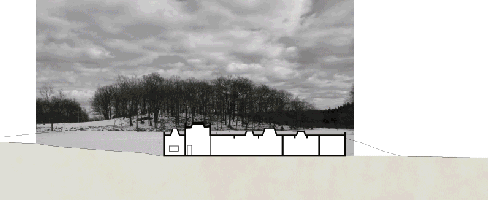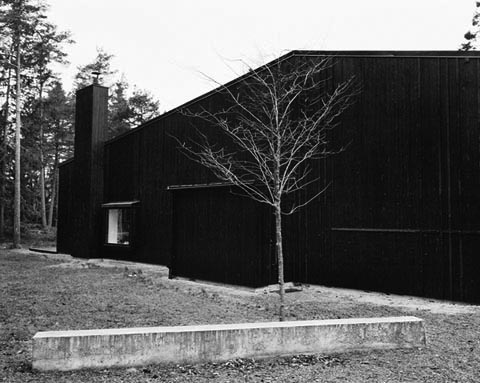| publications |
 |
Section Cemetery Maintenance Building, Ulriksdal, 2011. (IPOS and Petra Gipp) |
| • publications | • articles on architecture | • articles on art | • projects |
| Daniel A.Walser | • contact | • identity |
|
Specific Light and Shadow for an authentic place To name an architects office «In Praise of Shadows» or IPOS already suggests not a norm. The name refers directly to the essay of Jun'ichiro Tanizaki «In Praise of Shadows» (1933). The text focuses on the aesthetics of traditional Japanese architecture and discuses it in reference to western culture and the modernistic movement. The architecture office «In Praise of Shadows» very much attend to the phenomena described in the essay: the use of the building material, specific work with light, as well as what contemporary architecture can learn from local tradition and how different materials can be connected. How the handicraft or the industrial production is a part of the visual and aesthetic concept today and the interaction of spaces at different times of the day, as well as the relations of outside spaces, perspectives and views are all included in this architect office’s interests. A main theme, which always returns, is the interaction between contemporary architecture and contextual or typological roots of architecture in Sweden. As Katarina Lundeberg and Fredric Benesch do not use their own names nor a shortening of signature to define the office, their interest is not a focus on a purely artistic expression of architecture, nor in the promotion of their proper names. They address essential issues of basic architecture phenomena as light and shadow. Through their work they respond to an international discourse especially of the Nordic countries, and Switzerland. At the office «In Praise of Shadows» architecture is not understood as a kind of fashion but as a specific solution for explicit tasks. The results are well-defined architectural solutions, for specific sites, and catering for the needs and ideas of clients. The collaboration between Lundeberg and Benesch started in 2003 when they were paired as teachers in a first year studio at KTH School of Architecture. They held a studio in the bachelor program for a number of years. As for many professional architects the teaching became a second education, a possibility of verbalisation and activation of the professional experiences made so far. The questions from the students to be answered, the tasks to be formulated, the references to be given and not at least the study-trips to be undertaken formed a common ground upon which their office could be built.
Reality between construction, industry and truth The architects of IPOS see architecture not only as a formal question of design, but aim to influence and control the construction of a building. They are interested in the building as a whole. That the expression has something to do with the inner construction and the surface not just a covered plaster wall is important to these architects. Authentic material should be used and the aimed expression of the building should be reflected through its construction. But this is not always easy to achieve if the building industry offers only a limited range of construction possibilities in Sweden. One either accepts the range of constructions on offer or the architects have to search for new solutions. The IPOS architects aim to control the construction of each building as much as their colleagues in central Europe can do so. On one hand behind this is an admiration for good detaining, handcraft, and a precise industrial production. On the other hand it is a moral understanding that architecture needs to be true and designed in one idea. Model making plays an essential part in their work. The architects develop each project through a series of working models. Precise and carefully handcrafted models show the essence of a space. For the market place project in Gothenburg the architects carefully developed the structure of the project in such a way. They started with a kind of tree shaped column, which developed into large V shaped columns that are directly connected with each other. In defining a building more precisely the clarity of the supporting structure is a basic element to open up new architectural possibilities. A structure frames and forms the space in-between where people move and live. The structure or the supporting walls of Ulriksdal Cemetery Maintenance Building, the Solbrinken Residence or the market place project are part of the designing process. In these projects the structure forms the space. The structure is physically present. It is a clear consequence of the basic concept of the building. It reacts to the functions, the movement, and the site. Influences from abroad The Danish architecture education of Katarina Lundeberg for sure gave her a different point of view than if she had studied in Sweden. But with the unexpected development in recent years in Denmark one has to question what is different. The education was much more conceptualised and less artistic than in Sweden. A clear concept and the ability to defend and position oneself was a fundamental influence. Contemporary architects as Dorte Mandrup were at the University at the same time and had the impact that an interaction between Scandinavian architecture traditions, the existing building situation in Denmark and the contemporary architecture was possible. Fredric Benesch made similar experiences in Switzerland where he worked at the engineering office of the structural engineer Jürg Conzett in Chur. Here Benesch followed the development of the most important buildings in Switzerland of that time by Jüngling and Hagmann, Valerio Olgiati, Peter Zumthor, Gigon Guyer and others from a strictly structural side. He learned the value of traditional concepts, the incredible precise detailing, and the chance gained by using a clarified structure. He also learned what power existing concepts retain and what possibilities derive from developing a strict architecture system in form, construction, expression, and detailing through a whole building. Such an ambition also prevailed at the office of Anders Wilhelmson where Benesch worked for several years as project architect and office manager. Context and Typologies It is important for the architects of IPOS that existing traditional typologies are of as much value as contemporary building solutions, not as a model but as typologies, which can be updated and transferred. In their work IPOS focus on traditional typologies as a basic knowledge and use the methods of modernist architects as Gunnar Asplund, Sigurd Lewerentz, Arne Jacobsen and even Alvar Aalto to create new building solutions for the specific sites, which are rooted in the Swedish or Scandinavian building culture. The rural context at the edge of a village was a primary design force for the main housing of the Plintsberg Refugium and Hotel in Dalarna. The setting of the building ensemble is related to traditional farmstead buildings in Sweden. The inner courtyard is open but still shelters the buildings and forms a traditional working space. Even the form of the buildings refers to traditional farmhouses. Elements such as exposed staircases are part of traditional typology that is being transferred to contemporaneity in the play with the framed large windows.
Local references and international discourse The concrete staircase in the Ulriksdal Cemetery Maintenance Building serves as the main connecting element for the whole building. Light comes from above and intrudes the staircase like a sacred light. This central piece of architecture acts as a connecting element for all kinds of different functions and yet reminds us that the building services a cemetery. The staircase is astonishingly brightly lit due to the large roof window. The staircase itself reminds one of works by Luigi Snozzi and Aurelio Galfetti in Switzerland where the concrete shows the working process and the spacer grid elements of the formwork is geometrically set. But the atmosphere of the room remains Swedish, with a softer but clear northern light. In the structural thinking and the composition one makes the reference to Le Corbusier’s «promenade architecturale». In several buildings of Asplund as in the Woodland Chapel, the City Hall in Göteborg or the Asplund-summerhouse in Stennäs (1937), all of which are well known to the architects of IPOS, the path through the building is a kind of journey where space changes and different atmospheres are created. The architects of IPOS work in similar way. Every room of their buildings is specifically done – as seen in small houses as the Solbrinken Residence in Nacka (2009 as well as in the Ulriksdal Cemetery Maintenance Building or the apartment block HG7 in Stockholm (2011). All these buildings are characterized by movement through the interior, and the specific relations between building volume, façade material, construction, light and views to exterior. This functionalistic understanding of architecture at IPOS is very close to the intentions of Arne Jacobsen and in a much more organic way to Alvar Aalto. Alvar Aato extended the meaning of function with physical and emotional needs. The spaces IPOS develop are, even if they are white inside, not at all neutral. The white rooms as for example the sleeping room of the Solbrinken Residence in Nacka are every thing else than detached; such a room is situated in a clear position in relation to the house and the landscape by the inner shape of the room, the visual connection through the roof window and the light illuminating the walls. IPOS always aim to create rooms with a clear function and orientation.
Catalogue essay, January 2012, Daniel A. Walser
Exhibition«Presence», Royal Tecnical University KTH, Architecture Department, Stockholm |
|
Copyright © 2005-2015, Daniel A. Walser, Zurich, Switzerland. All rights reserved. |

 Solbrinken Residence, Nacka, 2009 (Photograph: IPOS)
Solbrinken Residence, Nacka, 2009 (Photograph: IPOS)